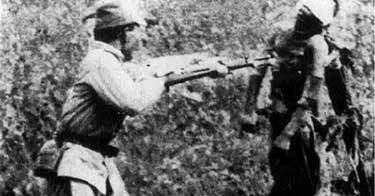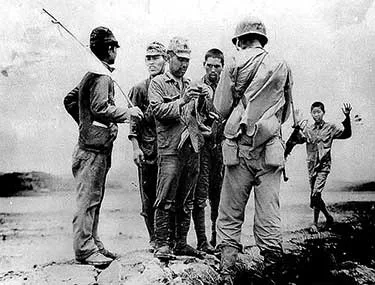The “Cruel” Koreans of the Japanese Army in the Philippines in World War II
In the midst of a discussion about Japanese atrocities committed in the Province of Batangas during the last world war, an acquaintance with whom I was having the discussion mentioned offhandedly that the Koreans in the Japanese army, or so he had heard, were actually nastier than the Japanese themselves.
I was born 14 years after the end of the war in the Pacific; but I had not heard of this before. I grew up in a generation that watched black-and-white movies of Japanese cruelty; but there was never any mention of Koreans. Still, I felt that my acquaintance’s statement was worth investigating.
Having previously written about the estimated 25,000 Batangueños slaughtered by the Japanese when it became increasingly evident that they were fighting a losing battle against Allied Forces near the end of the war, I wondered how much of the atrocities committed was actually the work of Koreans, if at all what my acquaintance said was true.
Paul H. Katroska, who wrote about forced labor in the Japanese empire during World War II, noted in his book that there were among Filipinos those who thought that there was a Korean Army distinct from the Japanese. According to him, some Filipino survivors of the war with whom he talked would often say, “The ones who were cruel during the Occupation were not the Japanese but the Koreans.1”
Was this true, however? Finding an answer to this question has turned out to be extremely difficult; and mostly because of one main reason.
Beginning in 1910, as a consequence of the Japan-Korea Treaty, the entire Korean peninsula was annexed by the Japanese Empire. The two Koreas – i.e. North and South – did not become independent nations until liberation from the Japanese in 1945 by the United States and the Soviet Union.
Thus, Koreans were essentially “Japanese,” or at least officially, up to the end of the war; and any Koreans in the Japanese Army in the Philippines and elsewhere were documented as Japanese.2
This was something that Katroska also pointed out in his book: “Although the Japanese army combined different ethnic and national elements, there was no special nomenclature such as “Japan-Korea Army,” to designate this force. Japan’s colonial policy aimed at the assimilation of Koreans, and until the end of the war it was official policy to regard Koreans as Japanese.1”
That there were Koreans in the Japanese Army, however, was well-documented. In 1938, in anticipation of war in the Pacific, the Japanese Army first opened its doors to Koreans. By 1944, when the tides of war had turned against the Japanese and manpower losses rose in the theater of war, all Korean males who were not already involved in war-related activities were required to enlist in the Japanese Army.2
Before required enlistment was enforced, however, some 3,000 Korean volunteers were given jobs that the Japanese felt were beneath them as a race of people. Among these jobs was guarding Allied prisoners-of-war. Guarding POWs was a job that the Japanese had so little regard for that in some cases, an entire unit of Koreans could be under the command of a Japanese soldier with the rank as low as that of a Lance Corporal3.
That the Koreans were cruel is also documented, but towards POWs and not towards the civilian population – or at least, according to documentation. This cruelty was imparted upon all Japanese soldiers by way of indoctrination in the tenets of bushido – the Samurai’s code – and Shinto – the Japanese religion.
“A culture of extreme brutality was also encouraged within the military itself… This brutality would be passed down the line from the Japanese officers to their own enlisted men who would then be expected to beat each other up. At the end of this chain of brutality were the men perceived by the Japanese to be the lowest of the low, their enlisted Koreans and Taiwanese, who received the worst beatings. The disgruntled Korean and Taiwanese camp guards had no one but the prisoners of war to beat up, and they were viewed by many prisoners as being the most brutal of their guards.4”
But were they at all involved in committing atrocities against the civilian population, majority of which were in the Province of Batangas? This is the part that is a tad more difficult to establish, and basically because the Koreans were, in a manner of speaking, hiding in plain sight in the Japanese Army.
At the end of the war, 25 Japanese personnel were indicted as Class A criminals (for crimes against peace) while some 5,700 were indicted as Class B (for war crimes) and Class C (for crimes against humanity). Of these numbers, 148 were ethnic Koreans.5
The most prominent of these Korean war criminals was Hong Sa-ik, who had risen to the rank of Lieutenant General and was in command of all POW camps in the Philippines. He was held responsible for all the acts of cruelty committed by his guards, predominantly Korean in ethnicity. He was found guilty in 1946 and subsequently hanged.6
Existing documentation, then, indicates two things. First, there were indeed Koreans in the Japanese Army in the Philippines in World War II, but they comprised a small percentage of the army. Moreover, they were mostly in auxiliary jobs that the Japanese felt beneath them.
Among these jobs was guarding POW camps, where they were admittedly cruel towards their prisoners. However, there does not seem to be documentation that they participated in the wanton killings around the Philippines but most notably in the Province of Batangas.
Therefore, it appears that the context of the Koreans’ cruelty in the POW camps was lost as it spread by word of mouth until this cruelty was eventually construed to mean towards the general population.
Ateneo de Manila professor Lydia Yu Jose noted that those who believed rumours about the Koreans being crueler than the Japanese could not, however, substantiate their beliefs.7
Several weeks back, I chanced upon wartime survivor Alex Maralit at the Museo de Lipa. His sketches, which depict Japanese brutality in Lipa towards the end of the war, are at the ground floor of the museum.
I spoke to him about the alleged cruelty of the Koreans; and his hypothesis was most interesting. According to him, it was possible that the rumours were something that the Japanese themselves had started to deflect blame away from themselves and onto the Koreans.
His point of view is echoed by University of the Philippines History professor Ricardo Trota Jose, who specializes in Military History and the Japanese Occupation of the Philippines. Like Maralit, Jose thinks that the Japanese themselves started the rumors to divert the blame onto the Koreans.8
2 Korea under Japanese rule, Wikipedia
3 The Japanese Army 1931-45 (2): 1942-45 by Philip S. Jowett
4 An Attempt to Explain Japanese War Crimes, Pacificwar.org
5 Japanese War Crimes, Wikipedia
6 Hong Sa-ik, Wikipedia
7 The Koreans in Second World War Philippines: Rumor and History, by Lydia Yu Jose as cited in the blog Just Some Stuff
8 Koreans in WWII Philippines: A Twist in History, by Jacqueline Arias



